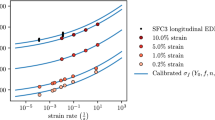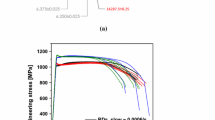Abstract
The short rod is a simple, inexpensive configuration for fracture toughness testing. Since no rigorous analytical stress-intensity factor calibration of this geometry has yet appeared, a three-dimensional finite element study was undertaken. Successively finer meshes were employed to investigate convergence in compliance versus crack length, and the dimensionless calibration constant, A, in the expression% MathType!MTEF!2!1!+-% feaafiart1ev1aaatCvAUfeBSjuyZL2yd9gzLbvyNv2CaerbuLwBLn% hiov2DGi1BTfMBaeXatLxBI9gBaerbd9wDYLwzYbItLDharqqtubsr% 4rNCHbGeaGak0dh9WrFfpC0xh9vqqj-hEeeu0xXdbba9frFj0-OqFf% ea0dXdd9vqaq-JfrVkFHe9pgea0dXdar-Jb9hs0dXdbPYxe9vr0-vr% 0-vqpWqaaeaabaGaciaacaqabeaadaqaaqaaaOqaaGqaciaa-Teada% WgaaWcbaacbaGaa4xmaiaa-ngaaeqaaOGaeyypa0Jaa8NramaaBaaa% leaacaWFJbaabeaakiaa-feacaGFVaGaa43waiaa-jeadaahaaqcba% uabeaalmaalyaajeaqbaGaaG4maaqaaiaaikdaaaaaaOGaaiikaiaa% igdacqGHsislcaWF2bWaaWbaaSqabKqaafaacaWFYaaaaOGaaiykam% aaCaaaleqajeaqbaWaaSGbaeaacaaIXaaabaGaaGOmaaaaaaGccaGG% Dbaaaa!4A74!\[K_{1c} = F_c A/[B^{{3 \mathord{\left/ {\vphantom {3 2}} \right. \kern-\nulldelimiterspace} 2}} (1 - v^2 )^{{1 \mathord{\left/ {\vphantom {1 2}} \right. \kern-\nulldelimiterspace} 2}} ]\]
Quarter-point singular elements were used along the crack front, and a range of crack lengths 0.65 <- a/B <- 1.1 was investigated. Distributed and point loading cases were considered. Polynomials were least-squares fit through the compliance data and were differentiated to yield expressions for average stress-intensity factor along the crack front% MathType!MTEF!2!1!+-% feaafiart1ev1aaatCvAUfeBSjuyZL2yd9gzLbvyNv2CaerbuLwBLn% hiov2DGi1BTfMBaeXatLxBI9gBaerbd9wDYLwzYbItLDharqqtubsr% 4rNCHbGeaGak0dh9WrFfpC0xh9vqqj-hEeeu0xXdbba9frFj0-OqFf% ea0dXdd9vqaq-JfrVkFHe9pgea0dXdar-Jb9hs0dXdbPYxe9vr0-vr% 0-vqpWqaaeaabaGaciaacaqabeaadaqaaqaaaOqaaGqaciaa-Teada% WgaaWcbaacbaGaa4xmaaqabaGccqGH9aqpdaWadaqaamaalaaabaGa% a8NramaaCaaaleqajeaybaGaa8Nmaaaakiaa-veacaWFNaaabaGaaG% Omaiaa-jgacaWFGaaaamaalaaabaGaa4hzaiaa-neaaeaacaqGKbGa% a8xyaaaaaiaawUfacaGLDbaadaahaaWcbeqcbauaamaalyaabaGaaG% ymaaqaaiaaikdaaaaaaaaa!477B!\[K_1 = \left[ {\frac{{F^2 E'}}{{2b }}\frac{{dC}}{{{\text{d}}a}}} \right]^{{1 \mathord{\left/ {\vphantom {1 2}} \right. \kern-\nulldelimiterspace} 2}} \]
Minima of this expression were obtained corresponding to critical average stress-intensity factors and crack lengths. The above expressions were then equated to solve for calibration constant values of,
% MathType!MTEF!2!1!+-% feaafiart1ev1aaatCvAUfeBSjuyZL2yd9gzLbvyNv2CaerbuLwBLn% hiov2DGi1BTfMBaeXatLxBI9gBaerbd9wDYLwzYbItLDharqqtubsr% 4rNCHbGeaGak0dh9WrFfpC0xh9vqqj-hEeeu0xXdbba9frFj0-OqFf% ea0dXdd9vqaq-JfrVkFHe9pgea0dXdar-Jb9hs0dXdbPYxe9vr0-vr% 0-vqpWqaaeaabaGaciaacaqabeaadaqaaqaaaOqaaGqaciaa-feacq% GH9aqpcaaIYaGaaGynaiaac6cacaaI5aGaaeiiaiabgglaXkaabcca% caqGXaGaaeOlaiaabkdacaqG1aaaaa!4227!\[A = 25.9{\text{ }} \pm {\text{ 1}}{\text{.25}}\]
at a c/B=0.86 for the distributed load case and
% MathType!MTEF!2!1!+-% feaafiart1ev1aaatCvAUfeBSjuyZL2yd9gzLbvyNv2CaerbuLwBLn% hiov2DGi1BTfMBaeXatLxBI9gBaerbd9wDYLwzYbItLDharqqtubsr% 4rNCHbGeaGak0dh9WrFfpC0xh9vqqj-hEeeu0xXdbba9frFj0-OqFf% ea0dXdd9vqaq-JfrVkFHe9pgea0dXdar-Jb9hs0dXdbPYxe9vr0-vr% 0-vqpWqaaeaabaGaciaacaqabeaadaqaaqaaaOqaaGqaciaa-feacq% GH9aqpcaaIYaGaaGimaiaac6cacaaI5aGaaeiiaiabgglaXkaabcca% caqGXaaaaa!4004!\[A = 20.9{\text{ }} \pm {\text{ 1}}\]
at a c/B=.69 for the point load case.
The distributed load case value of A is in very good agreement with previously reported values of 24.4 ± 1.3 and 25.0, and is about 11 percent higher than the currently recommended value obtained through K Ic correlation.
Preliminary results of a study of stress-intensity factor variation along the crack front are also presented. They show that maximum stress-intensity factor occurs at the edges of the crack front. This observation is consistent with the reverse tunneling phenomenon sometimes observed in short rod testing.
Recommendations for further numerical study of the short rod configuration are suggested.
Résumé
Le barreau court est d'une configuration simple et peu coûteuse pour les essais de ténacité à la rupture. Comme il n'est pas encore apparu de calibrage rigoureux du facteur d'intensité de contrainte relatif à cette géométrie, on a entrepris une étude par éléments finis à trois dimensions. Un maillage de plus en plus fin a été utilisé pour étudier la convergence entre la compliance et la longueur de fissuration ainsi que la constante de calibrage sans dimension A, dans l'expression de K Ic.
Le long du front de fissuration, on a eu recours à des éléments singuliers en quart point et on a examiné une gamme de longueurs de fissure rapportées au diamètre et comprise entre 0,65 et 1,1. On a envisagé des cas de mises en charge réparties et ponctuelles.
Les valeurs polynomiales ont été ajustées par la méthode des moindres carrés grâce aux donnés de compliance et ont été différenciées en vue d'aboutir à des expressions d'un facteur d'intensité de contrainte moyen le long du front de fissure.
Les minima de la valeur K I ainsi trouvés ont été obtenus en faisant se correspondre les facteurs d intensité critiques moyens de contrainte et les longueurs de fissuration, on a pu ainsi définir les valeurs de constante de calibration en faisant se correspondre K Ic et K I, et l'on a tiré
% MathType!MTEF!2!1!+-% feaafiart1ev1aaatCvAUfeBSjuyZL2yd9gzLbvyNv2CaerbuLwBLn% hiov2DGi1BTfMBaeXatLxBI9gBaerbd9wDYLwzYbItLDharqqtubsr% 4rNCHbGeaGak0dh9WrFfpC0xh9vqqj-hEeeu0xXdbba9frFj0-OqFf% ea0dXdd9vqaq-JfrVkFHe9pgea0dXdar-Jb9hs0dXdbPYxe9vr0-vr% 0-vqpWqaaeaabaGaciaacaqabeaadaqaaqaaaOqaaGqaciaa-feacq% GH9aqpcaaIYaGaaGynaiaac6cacaaI5aGaaeiiaiabgglaXkaabcca% caqGXaGaaeOlaiaabkdacaqG1aaaaa!4227!\[A = 25.9{\text{ }} \pm {\text{ 1}}{\text{.25}}\]
pour a c/B=0,86 correspondant à une mise en charge distribuée et
% MathType!MTEF!2!1!+-% feaafiart1ev1aaatCvAUfeBSjuyZL2yd9gzLbvyNv2CaerbuLwBLn% hiov2DGi1BTfMBaeXatLxBI9gBaerbd9wDYLwzYbItLDharqqtubsr% 4rNCHbGeaGak0dh9WrFfpC0xh9vqqj-hEeeu0xXdbba9frFj0-OqFf% ea0dXdd9vqaq-JfrVkFHe9pgea0dXdar-Jb9hs0dXdbPYxe9vr0-vr% 0-vqpWqaaeaabaGaciaacaqabeaadaqaaqaaaOqaaGqaciaa-feacq% GH9aqpcaaIYaGaaGimaiaac6cacaaI5aGaaeiiaiabgglaXkaabcca% caqGXaaaaa!4004!\[A = 20.9{\text{ }} \pm {\text{ 1}}\]
pour a c/B=0,69 dans le cas d'une mise en charge ponctuelle.
La valeur de A correspondant à la mise en charge répartie est en excellent accord avec les valeurs précédemment trouvée 24,4 ± 1,3 et 25,0 et est d'environ 11% supérieure à la valeur généralement recommandée obtenue par une corrélation avec K Ic.
On présente également les résultats préliminaires d'une étude de la variation des facteurs d'intensité de contrainte le long du front de fissuration. Ces résultats montrent que le facteur d'intensité des contraintes passe par un maximum aux bords du front de la fissure. Cette observation est conforme à un phénomène inverse à celui du phénomène tunnel, qui est rencontré parfois dans les essais de barreau court.
On suggère des recommandations pour une étude numérique complémentaire de la configuration du barreau court.
Similar content being viewed by others
References
L.M., Barker, Engineering Fracture Mechanics 9 (1977) 361–369.
L.M. Barker, in Fracture Mechanics of Ceramics, Vol. 3, Plenum Publishing Co. (1978) 12.
K.J. Bathe, E.L. Wilson, and F.E. Peterson, SAP IV Structural Analysis Program for Static and Dynamic Response of Linear Systems, Report No. EERC73-11 (June 1973, Revised April 1974), Earthquake Engineering Research Center, College of Engineering, University of California, Berkeley.
L.M. Barker and R.V. Guest, Compliance Calibration of the Short Rod Fracture Toughness Specimen, Terra Tek Report TR 78-20 (April 1978).
L.M. Barker and F.I. Baratta, Comparison of K Ic Measurements by the Short Rod and ASTM E399 Methods, Terra Tek Report TR 79-3 (January 1979).
R.T. Bubsey, D. Munz, W.S. Pierce, and J.L. Shannon, Jr., International Journal of Fracture (1980), accepted for publication.
R.A., Schmidt and T.J., Lutz, Fracture Mechanics Applied to Brittle Materials, ASTM STP 678 (1979) 166–182.
R.A. Schmidt, “Personal Communication”, June 1980.
R.S., Barsoum, International Journal of Numerical Methods in Engineering 11 (1977) 85–98.
A.R., Ingraffea and C., Manu, International Journal of Numerical Methods in Engineering 15 (1980) 1427–1445.
Author information
Authors and Affiliations
Rights and permissions
About this article
Cite this article
Beech, J.F., Ingraffea, A.R. Three-dimensional finite element calibration of the short-rod specimen. Int J Fract 18, 217–229 (1982). https://doi.org/10.1007/BF00032275
Received:
Issue Date:
DOI: https://doi.org/10.1007/BF00032275




